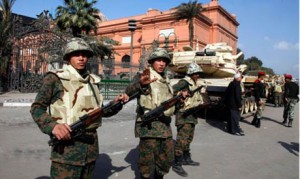An Egyptian soldier was shot and killed in the city of El Arish, Sinai peninsula (Northeast), the sixth fatality from the recent attacks which also cost the lives of three police officers, another soldier and a civilian.
Although military sources have refrained from providing official data, and have asked reporters to check reports with authorized sources, a report from anonymous witnesses identifies the victim as Abul Karin Mohammad, 21, something that gives the news some veracity.
The Sinai peninsula, which has hardly any media access, is the scene of an open war between the army and members of Islamist organizations, in an escalation of violence after the overthrow of President Mohamed Morsi on July 3rd, amid mass protests against his management, which opponents described as Islamist.
Meanwhile, Mohamed Mongey, a Muslim Brotherhood (MB) leader in the northern city of Suez, was sentenced to 10 years in prison for incitement to violence and vandalism against military properties.
MB leadership, including Mohamed Badie, its Supreme Leader, and Khairat al Shater, who was in charge of the group’s finances, are under arrest along with the overthrown president, pending a trial for inciting people to violence and ordering the death of opponents who attacked MB facilities in this city and other cities in the provinces.
Egypt Returns Stolen Antiquities to Ecuador and Peru
In an unusual event, Egypt, the victim of constant archaeological thefts, returned effigies to Ecuador and Peru that had been smuggled into the country.
The objects are three terracotta heads from the Valdivia culture, one of the first known cultures in what is now the Americas. The objects belong to Ecuador and were carved between the years 2,000 and 2,500 BC.
The Valdivia culture flourished near the present-day Ecuadorian city of Santa Helena.
Ecuadorian Ambassador Edwin Johnson received the tiny figures, which were sent to Egypt from the United States by an antique dealer some months ago and detected by Egyptian customs authorities with the cooperation of the Unit for Combating Trafficking of Antiquities.
During the ceremony, Antiquities Minister Mohamed Ibrahim gave Peruvian Ambassador Alberto Galve two Chancay Cuchimilco figures, one male and one female, made between 1,000 and 1,400 AD, long before Europeans came arrived to the continent.
The Egyptian official and the two diplomats remarked on the importance of the event, which highlights the global fight against the antiquities black market, today’s equivalent of grave robbers who plundered the tombs of the Pharaohs millennia ago.
The ceremony was of particular significance because it was held in a room of the famous Cairo Museum, in which there is a temporary exhibition of archaeological items that were looted in late January 2011, during the riots that forced ex-President Hosni Mubarak to resign.

